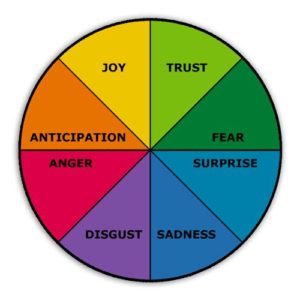Recent research has found that improved emotion regulation can prevent task conflict from turning into relationship conflict. (1) This means that improving self-awareness of your own hot buttons, learning how to delay your responses, and developing ways to cool down in the heat of conflict can help you resolve conflicts more effectively and avoid exacerbating matters.
REFLECT ON YOUR TRIGGERS
Learning more about your hot buttons helps prevent you from getting caught off guard when someone acts in a way that pushes one of your buttons. If you have taken time to reflect on why certain behaviors irritate you as well as how you want to respond when one of your buttons is pushed, you’ll be more aware of what is happening and can consciously slow things down to give you a chance to calm down and choose your next step.
THE EMOTION WHEEL
EFFECTIVE APPROACHES TO REGAIN COMPOSURE
A number of effective approaches can be used to regulate your emotions when they have been triggered. These include process to take your mind off of what is getting you upset as well as considering ways of reappraising the meaning of what has happened. (2) The key is to find a technique that works for you – one that you can use to regain your composure, no matter where you are at on the emotion wheel (pictured). This will enable you to consciously choose to use more constructive approaches when engaging with the other person.
(1) Curseu, P. , Boros, S., and Oerlermans, L., “Task and Relationship conflict in short-term and long-term groups: The critical roll of emotion regulation.” International Journal of Conflict Management. 2012, 23(1), 97-107.
(2) Runde, C. and Flanagan, T. Becoming a Conflict Competent Leader
(2nd Ed.). San Francisco: Jossey-Bass, 2012.


